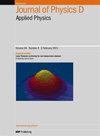室温脉冲激光沉积制备的金属/Nb:SrTiO3 肖特基触点中的电阻开关抑制作用
IF 3.1
3区 物理与天体物理
Q2 PHYSICS, APPLIED
引用次数: 0
摘要
深入了解金属/氧化物异质结中的界面型电阻开关(RS)是开发高性能忆阻器和肖特基整流器的关键一步。在这项研究中,我们通过脉冲激光沉积(PLD)制造了金属/掺镱硒氧化物(M/NSTO)肖特基接触原型,从而探讨了金属化技术的作用。超薄铂和金电极通过 PLD 沉积在单晶 (001) 端 NSTO 基底上,并通过传统的宏观方法和纳米级弹道电子发射显微镜对界面传输进行了表征。我们的研究表明,PLD 金属化可使肖特基触点在循环极化条件下具有高度可逆的电流-电压特性。室温(RT)传输受热电偶发射控制,其肖特基势垒高度为 ,ideality 因子小至 和 。当掺杂铌和外部刺激(极化偏置、工作温度、环境空气暴露)发生较大变化时,RS 几乎完全被抑制。在纳米尺度上,我们发现这两个系统都显示出高度的( )空间均匀性,而这种均匀性仅部分受到 NSTO 混合终端( )的影响。基于 M/NSTO 的金属-绝缘体-半导体描述的实验证据和理论论证表明,PLD 金属化可减轻导致 RS 的界面层效应。这要归功于界面层厚度的减小,以及有效阻隔了影响电荷捕获和氧化还原反应的环境气体的渗透。通过这种描述,我们可以从缓慢的界面再氧化角度来解释在环境空气中暴露数月后观察到的界面老化效应。我们的工作有助于从根本上理解界面型 RS,并证明 RT PLD 为实现稳健、无 RS 的基于 NSTO 的肖特基触点提供了一个可行的平台。本文章由计算机程序翻译,如有差异,请以英文原文为准。
Resistive switching suppression in metal/Nb:SrTiO3 Schottky contacts prepared by room-temperature pulsed laser deposition
Deepening the understanding of interface-type resistive switching (RS) in metal/oxide heterojunctions is a key step for the development of high-performance memristors and Schottky rectifiers. In this study, we address the role of metallization technique by fabricating prototypical metal/Nb-doped SrTiO3 (M/NSTO) Schottky contacts via pulsed laser deposition (PLD). Ultrathin Pt and Au electrodes are deposited by PLD onto single-crystal (001)-terminated NSTO substrates and interfacial transport is characterized by conventional macroscale methods and nanoscale Ballistic Electron Emission Microscopy. We show that PLD metallization gives Schottky contacts with highly reversible current-voltage characteristics under cyclic polarization. Room-temperature (RT) transport is governed by thermionic emission with Schottky barrier height , and ideality factors as small as and . RS remains almost completely suppressed upon imposing broad variations of the Nb doping and of the external stimuli (polarization bias, working temperature, ambient air exposure). At the nanoscale, we find that both systems display high spatial homogeneity of ( ), which is only partially affected by the NSTO mixed termination ( ). Experimental evidences and theoretical arguments—based on a metal-insulator-semiconductor description of the M/NSTO—indicate that the PLD metallization mitigates interfacial layer effects responsible for RS. This occurs thanks to the reduction of the interfacial layer thickness and to the creation of an effective barrier against the permeation of ambient gas species affecting charge trapping and redox reactions. This description allows to rationalize interfacial aging effects, observed upon several-months-exposure to ambient air, in terms of a slow interfacial re-oxidation. Our work contributes to the fundamental understanding of interface-type RS and demonstrates that RT PLD offers a viable platform for the realization of robust, RS-free NSTO-based Schottky contacts.
求助全文
通过发布文献求助,成功后即可免费获取论文全文。
去求助
来源期刊
CiteScore
6.80
自引率
8.80%
发文量
835
审稿时长
2.1 months
期刊介绍:
This journal is concerned with all aspects of applied physics research, from biophysics, magnetism, plasmas and semiconductors to the structure and properties of matter.

 求助内容:
求助内容: 应助结果提醒方式:
应助结果提醒方式:


